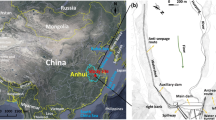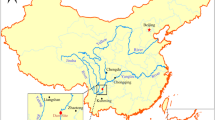Abstract
Anti-seepage calculation is key to the design of reservoir dams, and the uncertainty parameter makes the sensitivity analysis a useful tool in the design process. A reservoir constructed in northeastern China was selected to analyze optimal anti-seepage designs, and numerical models have been established with visual MODflow software. The results of analyzing seepage field characteristics show that under different schemes, anti-seepage capability is controlled by the length of an anti-seepage body on the left riverbank and the depth of curtain grouting, and that seepage decreases with increasing length of the anti-seepage body and depth of the curtain grouting. The results of the sensitivity analysis show that, according to the sensitivity analysis, the permeability coefficient had different effects on the seepage gradient under incomplete and complete anti-seepage. Under incomplete anti-seepage, the seepage increased with permeability coefficient and the seepage gradient increased; and under complete anti-seepage, the seepage increased slightly with the permeability coefficient, and the seepage gradient decreased, the permeability coefficient of the anti-seepage body clearly influences the anti-seepage effects. From a project investment standpoint, complete anti-seepage on the left riverbank with a curtain grouting standard of 5 Lugeon units (Lu) is the preferred anti-seepage control scheme. This scheme not only guarantees the safe operation of the dam but also ensures that seepage is less than the acceptable seepage limit, is close to the natural groundwater flow rate, and that the scheme will not significantly impact the downstream hydrogeological environment after the construction of the dam.








Similar content being viewed by others
References
Al-Fares W (2019) Characterization of the leakage problem in Salhab earthen dam using electrical resistivity tomography and SP measurements, Syria. Contrib Geophys Geodesy 49(4):441–458
Amaya PJ, Massey-Norton JT, Stark TD (2009) Evaluation of seepage from an embankment dam retaining fly ash. J Perform Constr Facil 23:406–414
Bayat M, Eslamian S, Shams G, Hajiannia A (2019) The 3D analysis and estimation of transient seepage in earth dams through PLAXIS 3D software: neural network case study: Kord-Oliya Dam, Isfahan Province Iran. Environ Earth Sci 78(18):571
Bruce DA (2013) Design, construction and performance of seepage barriers for dams on carbonate foundations. Carbonates Evaporites 28:229–241
Chen Q, Zhang LM (2006) Three-dimensional analysis of water infiltration into the Gouhou rockfill dam using saturated-unsaturated seepage theory. Can Geotech J 43:449–461
Chen XS, Wang WB, Liang H, Liu XL, Da LJ (2014) Dynamics of ruderal species diversity under the rapid urbanization over the past half century in Harbin, Northeast China. Urban Ecosyst 17:455–472
Chen XX, Chen JS, Wang T, Zhou HD, Liu LH (2016) Characterization of seepage velocity beneath a complex rock mass dam based on entropy theory. Entropy. 18:293
Cheng L, Yang Y, Chu J (2019) In-situ microbially induced Ca2+−alginate polymeric sealant for seepage control in porous materials. Microb Biotechnol 12(2):324–333
Dhawan KR, Burele S, Bagwan K (2019) Curtain Grounting, a tool used for stopping the seepage from an existing dam. Indian Geotech J 49(5):552–565
Dong HZ, Chen JS, Li XY (2016) Delineation of leakage pathways in an earth and rockfill dam using multi-tracer test. Eng Geol 212:136–145
Fadaei-Kermani E, Shojaee S, Memarzadeh R (2019) Numerical simulation of seepage flow through dam foundation using smooth particle hydrodynamics method. Int J Eng 32(4):484–488
Ghobadi MH, Khanlari GR, Djalaly H (2005) Seepage problems in the right abutment of the Shahid Abbaspour dam, southern Iran. Eng Geol 82:119–126
Kamble RK, Panvalkar GA, Chunade AD (2011) Mapping seepage in the tailrace channel, Bhama-Ashhed dam: a case study. Bull Eng Geol Environ 70:643–649
Kumar V, Samui P, Himanshu N, Burman A (2019) Reliability-based slope stability analysis of Durgawati Earthen Dam considering steady and transient state seepage conditions using MARS and RVM. Indian Geotech J 49(6):650–666
Lee JY, Kim HS, Choi YK, Kim JW, Cheon JY, Yi MJ (2007) Sequential tracer tests for determining water seepage paths in a large rockfill dam, Nakdong River Basin. Korea Eng Geol 89:300–315
Li JJ, Chen XD, Gu CS, Huo ZY (2019) Seepage comprehensive evaluation of concrete dam based on grey cluster analysis. Water. 11(7):1499
Liu Y, Shen JM, Chen ZL, Ren NQ, Li YF (2013) Distribution of polycyclic aromatic hydrocarbons in surface water and sediment near a drinking water reservoir in northeastern China. Environ Sci Pollut Res 20:2535–2545
Lu RL, Wei W, Sun DP (2013) Analysis of seepage field in multistage tailing dams area based on drainage system. Res J Chem Environ 17:73–81
Mehr SS, Raeisi E (2019) Investigation of seepage flow path(s) in the right embankment of Sheshpeer Dam, the Zagros Region, Iran. Carbonates Evaporites 34(4):1321–1331
Nourani V, Babakhani A (2013) Integration of artificial neural networks with radial basis function interpolation in earthfill dam seepage modeling. J Comput Civ Eng 27:183–195
Nourani V, Aminfar MH, Alami MT, Sharghi E, Singh VP (2014) Unsteady 2-D seepage simulation using physical analog, case of Sattarkhan embankment dam. J Hydrol 519:177–189
Peco J, Lopez-Querol S (2012) Displacement based coupled model for unconfined seepage problems applied to the Gasset Dam (Ciudad Real, Spain). Eng Geol 137:64–73
Petitta M, Mugnozza GS, Barbieri M, Fasani GB, Esposito C (2010) Hydrodynamic and isotopic investigations for evaluating the mechanisms and amount of groundwater seepage through a rockslide dam. Hydrol Process 24:3510–3520
Qiu JC, Zheng DJ, Zhu K (2016) Seepage monitoring models study of earth-rock dams influenced by rainstorms. Math Probl Eng 2016:1656738
Ren F, Ma GW, Wang Y, Fan LF (2016) Pipe network model for unconfined seepage analysis in fractured rock masses. Int J Rock Mech Min 88:183–196
Roushangar K, Garekhani S, Alizadeh F (2016) Forecasting daily seepage discharge of an earth dam using wavelet-mutual information-gaussian process regression approaches. Geotech Geol Eng 34:1313–1326
Rupp L, Niekamp O, Gebler T (2013) Modeling seepage flow at gravity dams on the example of Schwarza-Dam. Wasserwirtschaft. 103:30–33
Su XS, Xu W, Du SH (2014) Responses of groundwater vulnerability to artificial recharge under extreme weather conditions in Shijiazhuang City, China. J Water Supply Res Technol 63:224–238
Talouki HH, Lashkaripour GR, Ghafoori M, Saba AA (2015) Assessment and presentation of a treatment method to seepage problems of the alluvial foundation of Ghordanloo Dam, NE Iran. J Geol Soc India 85:377–384
Unal B, Celik M, Yildirim T (2008) Evaluation of seepage problems of the Armagan Dam, Kirklareli, Northwestern Turkey. Bull Eng Geol Environ 67:335–344
Uromehy A, Barzegarl G (2007) Evaluation and treatment of seepage problems at Chapar-Abad Dam, Iran. Eng Geol 91:219–228
Wang WC, Chau KW, Xu DM, Chen XY (2015) Improving forecasting accuracy of annual runoff time series using ARIMA based on EEMD decomposition. Water Res Manag 29:2655–2675
Xiang Y, Wang L, Wu SH, Yuan H, Wang ZJ (2015) Seepage analysis of the fractured rock mass in the foundation of the main dam of the Xiaolangdi water control project. Environ Earth Sci 74:4453–4468
Xu SG, Liu YY, Qiang PP (2014) River functional evaluation and regionalization of the Songhua River in Harbin, China. Environ Earth Sci 71:3571–3580
Xu ZG, Liu Y, Wang YP, Chai JR, Li YL (2020) Analysis of coupled three-dimensional seepage and temperature fields in fracture network of rock mass. Int J Comput Methods 17(4):1950005
Zarif S, Hamed R, Javdanian H (2019) Assessment of steady-state seepage through dams with nonsymmetric boundary conditions: analytical approach. Environ Monit Assess 192(1):3
Zeng XK, Wang D, Wu JC (2012) Sensitivity analysis of the probability distribution of groundwater level series based on information entropy. Stoch Env Res Risk A 26:345–356
Zhang LM, Chen Q (2006) Seepage failure mechanism of the Gouhou rockfill dam during reservoir water infiltration. Soils Found 46:557–568
Acknowledgments
The authors thank Professor Zisheng Liao for providing work assistance; we also wish to thank the reviewers and editors for their insightful comments to this manuscript.
Author information
Authors and Affiliations
Corresponding author
Additional information
Responsible Editor: Zhen-Dong Cui
Rights and permissions
About this article
Cite this article
Zhang, L., Yang, H., Sun, H. et al. Optimization analysis of seepage control design in Mopanshan Reservoir, northeastern China. Arab J Geosci 13, 298 (2020). https://doi.org/10.1007/s12517-020-05283-0
Received:
Accepted:
Published:
DOI: https://doi.org/10.1007/s12517-020-05283-0




